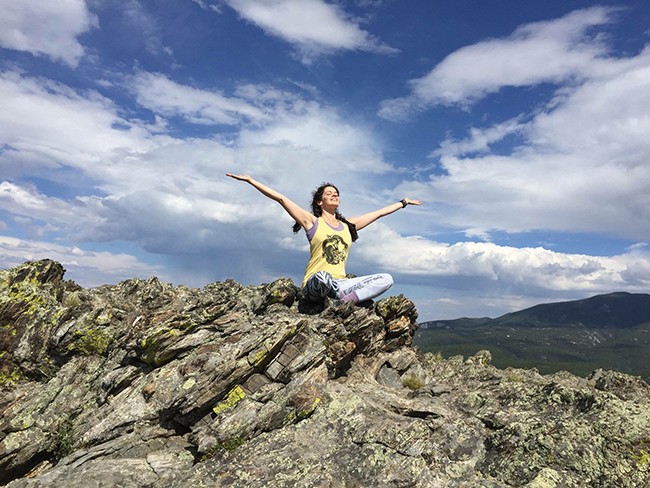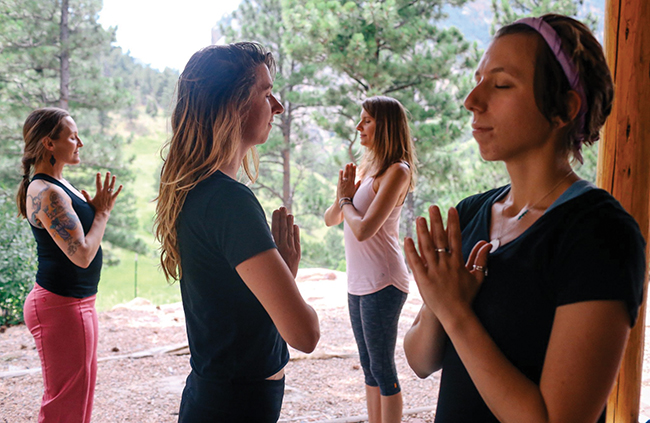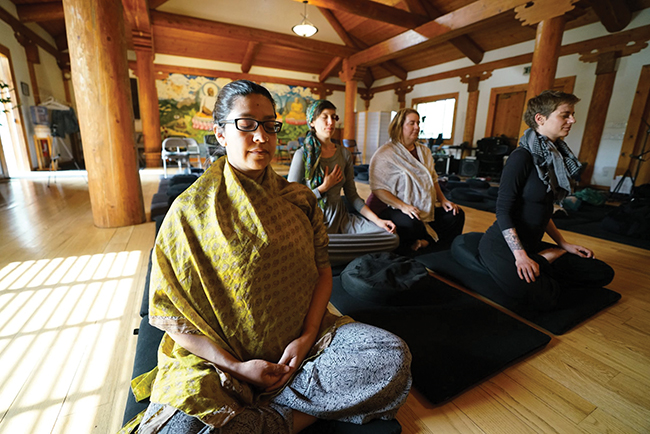A Season of Serenity
04 Oct 2023
Shoshoni Ashram's fall meditation escapes
By Cree Lawrence

Up twisty roads surrounded by nature’s best views lies the Shoshoni Ashram, a spiritual retreat center near Black Hawk. A calm and grounded energy seeps into your cells as you enter the property, which contains a gorgeous pond, two temples, a shrine, a yoga mandir and yoga cabin, a pottery studio, a lodge, a campground and multiple guest cabins—making it a wonderful spot to reconnect with nature and tap into the inherent joy of life.
In 1975, Rishi Mahn Mandaleshwar Sri Shambhavananda and a small group of yogis brought ShambhavAnanda Yoga, which centers meditation, to Boulder. Prior to opening the mountain retreat, their focus was Swami Rudranda, a vegetarian restaurant that later funded the Shoshoni Ashram. The ashram, nestled within 300 acres of Rocky Mountain forests, creates a harmonious space for people looking to experience yogic traditions through asana practice, meditation, retreats, seve (self-service) and nourishing meals.
Shoshoni was built in 1986, and its staff has been hosting guests since 1988. There are various ShambhavAnanda Yoga ashrams and affiliate centers scattered across Colorado and throughout the United States as well. Sri Shambhavananda’s wife, Faith Stone—an internationally recognized artist who crafts modern Buddhist and Hindu art—contributed widely to the creation and success of the Shoshoni Ashram. Today, Shoshoni hosts thousands of people as volunteers, retreat goers and employees every year.
Shoshoni strives to encourage practices that help you open your heart, still your mind and find your bliss. “Shoshoni’s mission is to immerse visitors in nature and to [practice] ancient yogic practices,” says Shakti Wood, a manager at Shoshoni who guides teacher trainings and retreats. “We really develop a foundation with those practices in order to find more joy and more happiness in our own lives.”
They also advocate for universal and fair accessibility to yoga and meditation, harnessing the wisdom gained from their inner spiritual practices to actively promote racial and social justice. Their commitment involves actively listening, self-education, engagement and ongoing personal development in order to support Black, Indigenous and other marginalized communities.

Visitors of the ashram can also enjoy vegetarian dishes catered to all preferences and restrictions and explore the ashram’s three hiking trails: Meditation Trail, Buddha Rocks Trail and Rolling Peak Trail. For day visitors, retreats begin with an art class and yoga session, followed by lunch, free time and meditation.
Many programs are customized to the seasons, too. “Fall is a chance to find yourself in a more introspective space where you can really do some inner work and have a quieter, calmer kind of arena to help you turn inside,” says Wood. During the fall season, Shoshoni hosts various retreats that center women, health and happiness, malas and mantras, meditation and healing.
“With our Women's Retreat, of course, we're offering it because it feels so special to be able to gather women together and share stories, space and challenges and really support each other through transitions,” says Wood. “We support each other using the energy of the goddesses. So, not just us as people, but this cosmic energy of manifestation and healing that the goddesses represent in that Divine Mother aspect.” This retreat includes jewelry making, introduction to the Ma Shrine and Goddess meditation, a tea and sharing circle, journaling, a Bhakti Bath with music and restorative yoga, deep relaxation practices and a goddess chant circle.
The Health and Happiness Retreat is something new to Shoshoni. Yogini, another manager at the ashram, leads the retreat. Through yoga, Yogini—a certified physical therapist—identifies physical patterns of imbalance and how to better honor the physical body and develop healthy habits. But she goes deeper than that, too, incorporating breath work (pranayama) as a way to manage stressors and trauma. Visitors will also participate in sacred art, yoga philosophy and an Ayurvedic cooking class.
But cooking classes aren’t limited to the Health and Happiness Retreat. The Cooking from the Heart retreats, led by head chef Tashi Saucier, explore various cuisines, including Japanese, Thai and Indian dishes as well as sourdough bread and pastries.

Rishi Mahn Mandaleshwar Sri Shambhavananda: The Visionary Behind the Ashram
Rishi Mahn Mandaleshwar Sri Shambhavananda, affectionately known as Babaji among his students, was the visionary behind the Shoshoni Ashram, along with two other flourishing ashrams. He authored three books and played a pivotal role in establishing numerous ShambhavAnanda Yoga Centers.
Sri Shambhavananda’s early years were spent on a dairy farm in western Pennsylvania, where even as a young child, he exuded joy and displayed an innate spiritual understanding that foreshadowed his future role as a spiritual leader.
His own spiritual mentors were Swami Rudrananda and Swami Muktananda of the Siddha Yoga tradition. It was Muktananda who once told Sri Shambhavananda that, “someday you’re going to live in the mountains and you’re going to have an ashram, and thousands of people will come to visit you.” At the time, he may have dismissed this notion as a joke, but little did he realize that this prophetic conversation would soon become a reality.
Falling into Mindfulness
As the seasons shift, nurture your spirit with two autumnal meditations
With the crisp embrace of autumn upon us, we invite you to partake in a soothing practice known as the "Wish to Grow" meditation, one you can effortlessly engage in from the cozy confines of your home. This meditation serves as a guiding light through the denser fall and winter days to help you gracefully navigate the introspective seasons ahead.
To begin, sit quietly. Arrive on your seat and draw your senses inward. Become more aware of how you feel in the moment. Notice the quality of your breath. Bring awareness to your heart and, from a heart-centered place, proclaim, “I deeply wish to grow.” You can make this intention specific, for example, “I wish to grow spiritually, or I deeply wish to grow in my discipline.” You can also keep the statement open-ended. Breathe into your heart and feel it expand. Maintain the sense of expansion with each inhale and exhale. Sit for ten or more minutes repeating the mantra, “I wish deeply to grow.”
Wood explains, “For me, what happens is that at first, I'm saying ‘Oh, I deeply wish to grow,’ and it feels more superficial; it's like asking from the surface. But the more I sit and really work with that, it starts to come from a deeper and deeper place within myself.”
Rudrananda also offers a guided “Letting Go” meditation to turn your attention toward shedding layers and letting go of that which does not serve you. Follow the QR code to find the practice.












